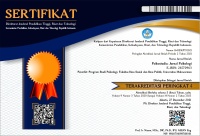The Role of Emotion Regulation on Compulsive Shopping of Clothing
Abstract
During the Covid-19 pandemic, almost all student activities are carried out from home, whether for lectures, shopping, etc. The number of activities carried out at home for a long period has resulted in students feeling bored/bored and feeling pressured by their routine activities. They seek entertainment by looking at the products offered in online store outlets. This can encourage students to spend excessively or compulsively, especially for students who are less able to regulate emotions. This study aims to empirically prove the effect of emotion regulation on compulsive shopping and wants to know the dimensions of emotional regulation inability that support students' compulsive spending. This study uses a quantitative approach. The subjects of this study amounted to 166 active students of the Faculty of Psychology, University of Muhammadiyah Malang. The data collection methods used were the Difficulties in Emotion Regulation Scale (DERS) and the compulsive shopping scale for clothing. Data analysis was performed using the regression analysis method with the help of the SPSS version 21 program. The results of the analysis showed that there was an influence of emotion regulation on compulsive clothing shopping. The dimensions of difficulty controlling impulses and refusing to realize emotions are dimensions of the inability to regulate emotions that play a major role in compulsive shopping for clothes.
Di masa pandemi Covid 19 ini hampir semua aktivitas mahasiswa dilakukan dari rumah, baik untuk aktivitas perkuliahan, berbelanja, dll. Banyaknya aktivitas yang dilakukan dilakukan di rumah dalah kurun waktu yang cukup lama ini mengakibatkan mahasiswa merasa jenuh/bosan dan merasa tertekan dengan aktivitas-aktivitas rutinnya. Mereka mencari hiburan dengan melihat-lihat produk yang ditawarkan di gerai toko online. Hal ini dapat mendorong mahasiswa untuk melakukan pembelanjaan secara berlebihan atau kompulsif terutama pada mahasiswa yang kurang mampu melakukan regulasi emosi. Penelitian ini bertujuan untuk membuktikan secara empiris pengaruh regulasi emosi terhadap belanja kompulsif dan ingin mengetahui dimensi ketidakmampuan regulasi emosi yang mendukung pembelanjaan kompulsif mahasiswa. Penelitian ini menggunakan pendekatan kuantitatif. Subjek penelitian ini berjumlah 166 mahasiswa aktif Fakultas Psikologi Universitas Muhammadiyah Malang. Metode pengumpul data yang digunakan adalah skala Difficulties in Emotion Regulation Scale (DERS) dan skala belanja kompulsif pakaian. Analisis data dilakukan dengan metode analisis regresi dengan bantuan program SPSS versi 21. Hasil analisis menunjukkan bahwa ada pengaruh regulasi emosi terhadap pembelanjaan kompulsif pakaian. Dimensi kesulitan mengontrol impuls dan menolak menyadari emosi merupakan dimensi ketidakmampuan melakukan regulasi emosi yang berperan besar terhadap belanja kompulsif pakaian.
Keywords
Full Text:
ENReferences
Andriyanto, D. S., Imam. S., Dahlan. F. (2016). Pengaruh Fashion Involvement dan Postive Emotion terhadap Impulse Buying (Survey pada Warga Keluruhan Kecamatan Lowokwaru Kota Malang). Jurnal Administrasi Bisnis (JAB). Vol. 31, No.1. hal. 42-49.
Billieux, J., Rochat, L., Rebetez, M. M. L. & Linden, M. V. D. (2008). Are all facets of impulsivity releted to self-reported compulsive buying behavior? Personality and Individual Differences, 44,1432-1442. https://doi.org/10.1016/j.paid.2007.12.011
Bong. S. (2011). Pengaruh In-Store Stimuli terhadap Impulse Buying Behavior Konsumen Hypermarket di Jakarta. Jurnal Ultima Management. Vol.3 No.1, hal. 31-52.
Cao, W., Fang, Z., Hou, G., Han, M., Xu, X., Dong, J., & Zheng, J. (2020). The psychological impact of the Covid-19 epidemic on collage students in China. Psychiatry Research, 287, 1-5. https://doi.org/10.1016/j.psychres.2020.112934
Chusniasari, P. (2015). Pengaruh Shopping lifestyle Fashion Involvement & Hedonic Shopping terhadap Impulse Buying Pelanggan. Jurnal Ilmu & Riset Manajemen. Vol.4, No. 12, hal. 1-21.
Diba. S. (2014). Peran Self control terhadap Pembelian Impulsif pada Remaja berdasarkan Perbedaan Jenis Kelamin di Samarinda. E-journal Psikologi. Vol.1, No. 2, hal. 313-323.
Dittmar, H. & Drury, J. (2000). Self-image – is it in the bag? a qualitative comparison between “ordinary” and “excessive consumers”. Journal of Economic Psychology, 21, 109-142.
Dittmar, H. & Kapur, P. (2011). Consumerism and well-being in India and the UK: identity projection and emotion regulation as underlying psychological processes. Psychological Studies, 56 (1),71-85. https://doi.org/10.1007/s12646-011-0065-2
Dittmar, H. (2004). Are you what you have? consumer society . The Psychologist, 17 (4), p. 206-211.
Dittmar, H. (2005). Compulsive buying – a growing concern? An examination of gender, age, and endorsement of materialistic values as predictors. British Journal of Psychology, 96, p. 467-491. https://doi.org/10.1348/000712605x535333
Dittmar, H., Long, K. & Bond, R. (2007). When a better self is only a button click away: associations between materialistic values, emotional and identity–related buying motives, and compulsive buying tendency online. Journal of Social and Clinical Psychology, 26 (3), 334-361. https://doi.org/10.1521/jscp.2007.26.3.334
Eren, S. S., Filiz. E., Gungor. H. (2012). Compulsive Buying Tendencies Through Materialistic and Hedonic Value among College Students in Turkey. Procedia Social and Behavioral Sciences. Vol. 58, hal. 1370-1377.
Feldman, R. S. (2013). Understanding psychology. Twelfth Edition. New York: McGraw-Hill Education.
Filomensky, T. Z. & Tavares, H. (2009). Cognitive restructuring for compulsive buying. Rev Bras Psiquiatr, 31(1), 76-81.
Flórez, L. E. G., Escobar, M. I. C., Restrepo, A. H., Botero, D. A., & Arias, A. V. (2017). Influence of social networks on the purchase decisions of university students. Cuadernos de Gestión, 18 (1) ,61-84. https://doi.org/10.5295/cdg.150577lj
Grant, J. E., Potenza, M. N., Weinstein, A., & Gorelick, D. A. (2010). Introduction to behavioral addictions. Am J Drug Alcohol Abuse, 36(5), 233-241. https://doi.org/10.3109/00952990.2010.491884
Grat, K. L. & Roemer, E. (2004). Multidimentional assessment of emotion regulation and dysregulation: development factor structure and initial validation of the difficulties in emotion regulation scale. Journal of Psychopathology and Behavioral Assessment, 26 (1), 41-54
Gratz, K. L. (2007). Targeting emotion dysregulation in the treatment of self-injury. Journal of Clinical Psychology, 63 (11), 1091-1103. https://doi.org/10.1002/cjlp.20417
Gross, J. J. (2007). Handbook of emotion regulation. London: The Guilford Press.
Günüç, S. & Keskin, A. D. (2016). Online shopping addiction: symptoms, causes and effects. Addicta: The Turkish Journal on Addictions, 3, 353–364. http://dx.doi.org/10.15805/addicta.2016.3.0104
Herabadi. A. G., Verplanken. B., & Knippenberg, A. V. (2009). Consumption experience of impulse buying in Indonesia: Emotional Aroousal and Hedonistic Considerations. Asian Journal of Social PsFHenychology. Vol. 12, No. 1, hal. 20-31.
Hermanto. E. Y. (2016). Pengaruh Fashion Involvement terhadap Impulse Buying Behavior Masyarakat Surabaya dengan Hedonic shopping Motivation & Positive Emotion sebagai Variabel Intervening pada Merek Zara. Jurnal Manajemen Pemasaran. Vol.10, No. 1, hal. 11-19. ISSN: 1907-235X.
Hetharie. J. A. (2012). Peran Positive Emotion sebagai Mediator Stimulus Lingkungan Toko dan Faktor Sosia terhadap Impulse Buying Tendency pada Matahari Departement Store Kota Ambon. Jurnal Aplikasi Manajemen. Vol. 10, No. 4, hal. 890-898. Terakreditasi No.66b/ Dikti/ Kep/ 2011. ISSN: 1093-5241.
In’am. M. F., Suharyono., Edy. Y. (2016). Analisis Faktor-Faktor yang Berpengaruh terhadap Pembelian Impulsif (Survei pada Pengunjung yang Melakukan Pembelian Impulsif di Distro 3 Second Cabang Mall Olympic Garden Malang). Jurnal Administrasi Bisnis (JAB). Vol.36, No.1, hal. 92-100.
LaRose, R., Lin, C. A, & Eastin, M. S. (2003). Unregulated internet usage:addiction, habit or deficien self-regulation?. Media Psychology, 5, p. 225-253
Leba, E. (2015). Pengaruh Atmosfer Gerai dan Promosi Terhadap Pembelian Impulsif yang Dimediasi Positive Emotion. Jurnal Ilmu dan Riset Manajemen. Vol 4, No. 1.
Naomi. P & Iin. M. (2008). Faktor-Faktor yang Mempengaruhi Siswa SMA dalam Perilaku Pembelian Kompulsif: Persepektif Psikologi. Jurnal UPI.
Norberg, M. M., Davidi, J., Crone, C., Kakar, V. Kwok, C., Olivier, J. & Grisham, J. R. (2020). Determinants of object choice and object attachment: Compensatory consumption in compulsive buying–shopping disorder and hoarding disorder. Journal of Behavioral Addictions, 9(1), 153-162. https://doi.org/10.1556/2006.8.2019.68
O’Reilly, C. (2016). The effect of social media and compulsive behavior on younger and older adults. Department of Social Science. DBS School of Arts. Dublin.
Otero-Lopes, J. M. & Villardefracos, C. (2014). Prevalence, sociodemographic factors, psychological distress, and coping strategies related to compulsive buying: a cross sectional study in Galicia, Spain. BMC Psychiatry, 14, 1-12.
Pradipto. Y. D., Caroline. V, Kharisma. M., Afifah. A. (2016). Think Again Before Yu Buy: The Relationship Between Self Regulation and Impulsive Buying Behaviors among: Jakarta Young Adults. ELSEVIER: Procedia Sosial and Behavioral Seciences, Page 177-185.
Santrock. J. W. (2011). Adolescence: Perkembangan Remaja. Edisi ke Enam. Jakarta: Erlangga
Schiffman, L.G., Kanuk, L.L. & Wisenblit, J. (2010). Consumer behavior. Tenth Edition. New Jersey: Prentice Hall International, Inc.
Septianto, F. (2013). Anxiety, sadness and emotion specificity: the role of music in consumer emotion and advertisement evaluation. Asean Marketing Journal, V (2), 83-92.
Setiadi, I. M. W. & I. G. K. W. (2015). Pengaruh Fashion Involvement terhadap Impulse Buying Konsumen Fashion yang dimediasi Positive Emotion di Kota Denpasar. E-Journal Manajemen Unud. Vol. 4, No. 6, hal. 1684 -1700. ISSN: 2302-8912.
Setyaningrum. F. Y., Zainul. A., Edy. Y. (2016). Pengaruh Hedonic Motives terhadap Shopping Lifestyle dan Impulse Buying (Survei pada Konsumen Superindo Supermarket yang melakukan Impulse Buying). Jurnal Administrasi Bisnis (JAB). Vol. 37, No. 1, hal. 97-104.
Trautmann-Atmann, J. & Johnson, T.W. (2009). Compulsive consumtion behaviours: investigating relationships among binge eating, compulsive clothing buying and fashion orientation. International Journal of Consumer Studies, 33, 267-273. https://doi.org/10.1111/j.1476431.2009.00741.x
Ureta, I. G. (2007.) Addictive buying: causes, processes and symbolic meanings. Thematic analysis of a buying addict’s diary. The Spanish Journal of Psychology, 10(2), 408-422
Verhagen, B., & Dolen. A. (2011). Individual Differences in Impulse Buying Tendency: Feeling and no Thinking. Euoropen Journal of Personality. Vol.15, No. 1.
Wilda. E. (2011). Peningkatan Kompetensi Intrapersonal Siswa SMK melalui Model Konseling Sebaya. Mimbar. Vol. 27, No. 2, hal. 173-182. Terakreditasi No. 64a/DIKTI/Kep/2010.
William, A. D. (2012a). Are compulsive buyer impulsive? evidence of poor respon inhibition and delay discounting. Journal Experimental of Psychopathology, 3(5), 794-806. https://doi.org/10.5127/jep.025211
William, A.D & Grisham, J. R. (2011). Impulsivity, emotion regulation, and mindful attentional focus in compulsive buying. Cogn Ther Res. Springer-Science Business Media. https://doi.org/10.1007/s10608-0119384-9
William, A.D. (2012b). Evaluation of the mood repair hypothesis of compulsive buying. Open Journal of Psychiatry. 2, 83-90. https://doi.org/10.4236/ojpsyh.2012.22012
Zahra N., Z., Kazemi; Y., & Khosravy, M. (2013). Study role of different dimensions of emotional self-regulation on addiction potential. Journal of Family and Reproductive Health, 8 (2), 69-72.
DOI: http://dx.doi.org/10.30872/psikostudia.v11i1.7169
Refbacks
- There are currently no refbacks.
Copyright (c) 2022 Psikostudia : Jurnal Psikologi

This work is licensed under a Creative Commons Attribution-ShareAlike 4.0 International License.
Psikostudia: Jurnal Psikologi is indexed by :
PSIKOSTUDIA: Jurnal Psikologi Published by Faculty of Social and Political Siences, University of Mulawarman, Samarinda, East Kalimantan and This work is licensed under a Creative Commons Attribution-ShareAlike 4.0 International License.
_________________________________________
PSIKOSTUDIA: Jurnal Psikologi
Department of Psychology
Faculty of Social and Political Siences, University of Mulawarman
Jl. Muara Muntai Kampus Gn. Kelua Samarinda 75411
Phone: +62 813 35350368
E-Mail: psikostudia@fisip.unmul.ac.id




















